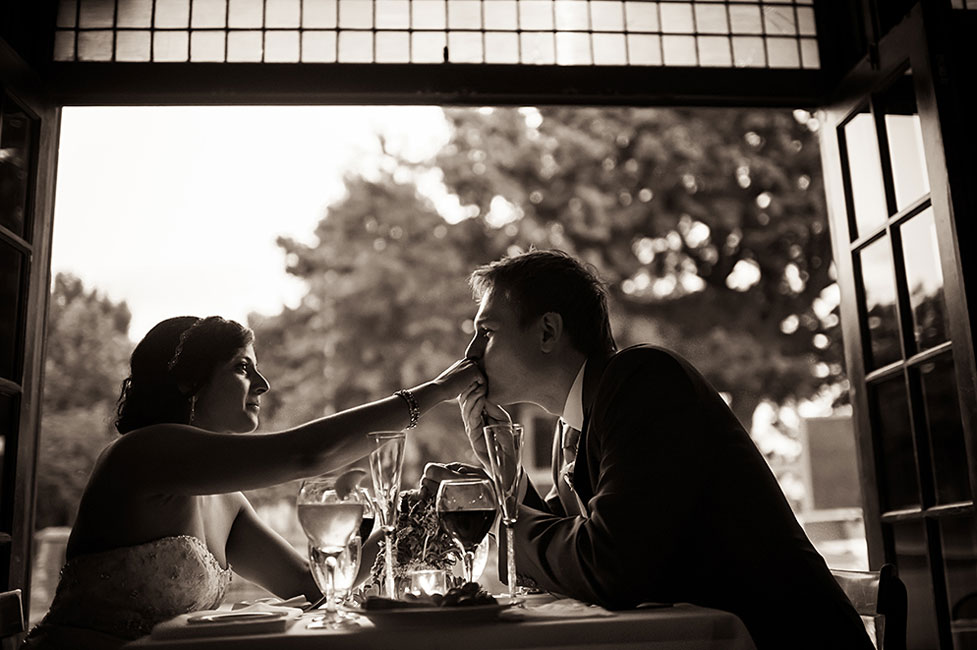Capturing Moments in a Wedding Day
Moments. When it comes right down to it, is there anything more important that capturing real, decisive moments on a wedding day? My answer is no. To me, capturing moments throughout the wedding day is paramount. Prior to my wedding career, I spent 15 years shooting 6,000 assignments for the Philadelphia Inquirer newspaper. After my foray into weddings somewhere around 1997, I realized that there were so many different elements of the wedding day that I needed to learn. The photojournalism aspect came naturally for me, but I needed to learn how to make a bride look beautiful—not just interesting. Over time, I evolved into a more well-rounded shooter, and my ability as a portraitist rewarded me with tremendous satisfaction when I was able to capture the essence and the beauty of my brides and couples with creative portraiture.
However, as satisfying as it was for me to produce beautiful portraits, I found myself always being drawn to the moments I discover and capture, rather than the moments I create. There’s something so beautiful about the “found” moment. There are hidden moments, quiet moments, solemn moments, tender moments, moments of jubilation, uncomfortable moments, and other moments that run the gamut of emotion throughout such a momentous occasion. Our job as the documentarian for these events is to make sure these moments are timeless. Before we can do that, we need to make sure we capture them to begin with!
When I begin the wedding day, I do my best to make my “footprint” rather small. I’ll walk in with a quiet voice, quiet feet, and I’ll be wearing two camera bodies. No Speedlights, nothing else on my person. I’m a man in a women’s world, and I need to be as unobtrusive as possible. My workhorse cameras are my D4’s. As of this day, as I’m writing this article, I’ll be replacing my D4 bodies with D4S bodies. The high ISO performance of these cameras allows me to shoot in some of the most brutal lighting conditions I face. All I really need is a sliver of quality light and I’m all set.
With my AF-S NIKKOR 35mm f/1.4G on one body, and my AF-S NIKKOR 85mm f/1.4G on the other body, I’ll begin the day in Aperture priority, and I’ll adjust the exposure compensation as needed. Generally, I love shooting these lenses wide open at f/1.4. My goal is to isolate my subject’s emotions and expressions, and eliminate distractions in my backgrounds. There’s nothing like a shallow depth of field to accomplish just that.
The key to sharp images while shooting wide open is focusing technique. By choosing the focus point nearest to my subject, I’ll focus on that subject without recomposing the camera when I fire the shutter. When shooting wide open, if you’re close to your subject, any change in the distance between the intended subject and the camera’s sensor may cause an out of focus image. Focusing technique is essential when shooting at wide open apertures, and it takes some practice to become proficient. The reward, however, is a stunning look and feel, and it can’t be accomplished without these amazingly fast lenses.
My goal is to make beautiful photographs. If I need to have a hand in certain elements of a photo, I’ll do it...I may help set the stage for certain moments to take place, but I will never stage a moment.
I’m often asked about certain images and whether they’re “set-up” or not. As a wedding photographer, I don’t feel the pressure of maintaining my journalistic integrity the way I did when shooting photojournalism. My goal is to make beautiful photographs. If I need to have a hand in certain elements of a photo, I’ll do it. For example—I may help set the stage for certain moments to take place, but I will never stage a moment. If I can help a bride and her mother move into some beautiful light to do something they’re already doing, or perhaps something they’ll need to do, I’ll move them—rather than shoot in less flattering light. However, in the end, the moment is theirs, not mine.
You can take me out of photojournalism, but you can’t take the photojournalism out of me. I will never go so far as to tell people exactly what to do while shooting them unless it’s truly a staged portrait. But when a beautiful moment is captured in beautiful light, I’ve made a beautiful photograph. That’s my goal throughout the day.
Each and every wedding is truly a story. My job is to tell that story in the most timeless fashion possible. My mission is to capture moments that last for generations, not just until the first anniversary when they whip out the album to reminisce. I don’t want my bride saying to her groom “aw, I remember that—that was when Cliff told us to do that.” I want her to say “wow, I remember that, that’s when you whispered in my ear.”
Timing, anticipation, and reaction to each and every moment is what’s required to capture these memories for our clients. Making sure your gear is an extension of your mind’s eye, and making sure your technical abilities are instinctive is the only way to produce these incredibly important moments. I bring eight lenses with me to a wedding. I use each and every one. There are different focal lengths for various parts of the day, and without these tools I couldn’t do what I do. After 32 years of developing my Nikon hands and NIKKOR eyes, I don’t really need to think much. I just try and capture these moments for generations to come.






